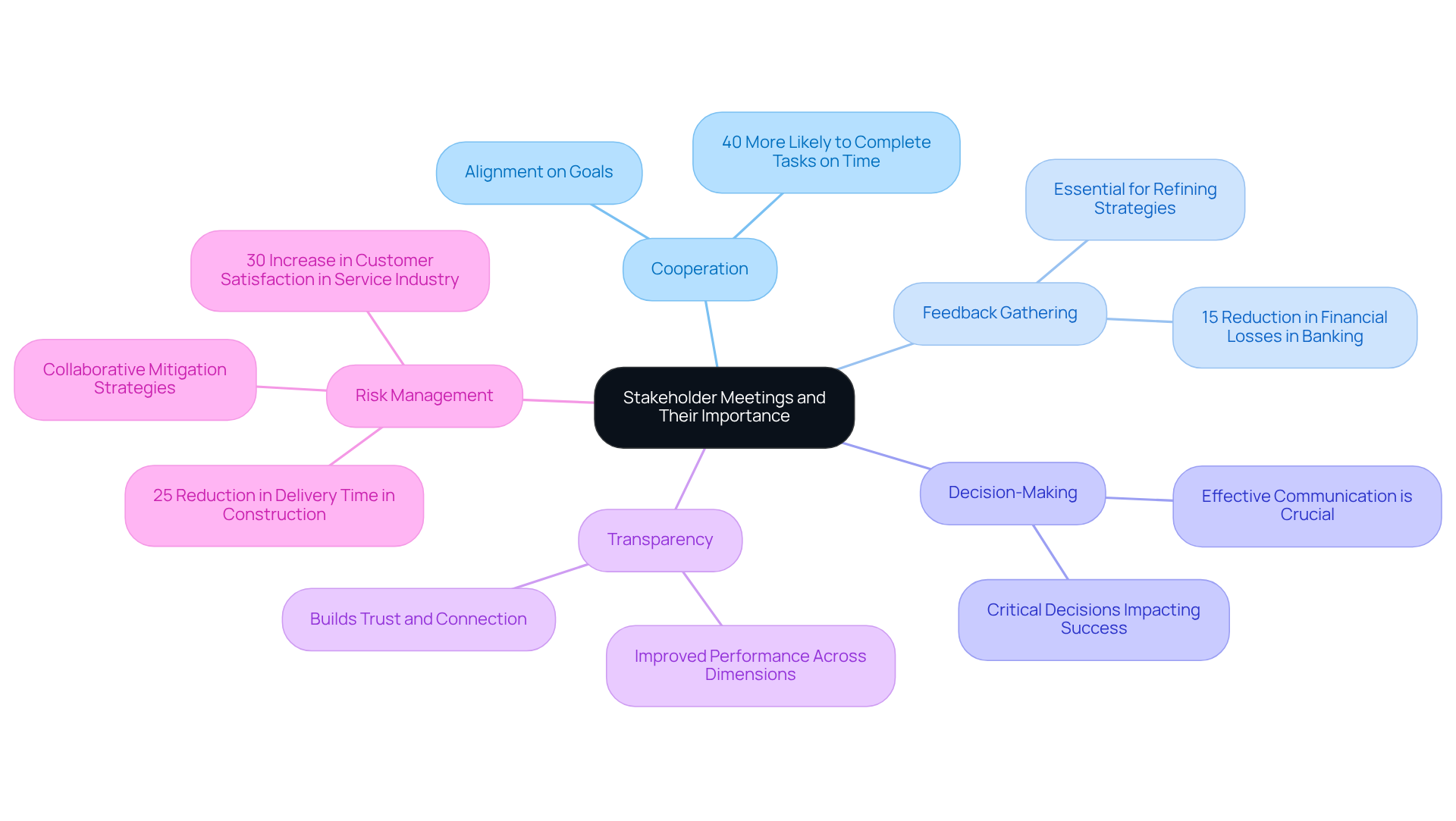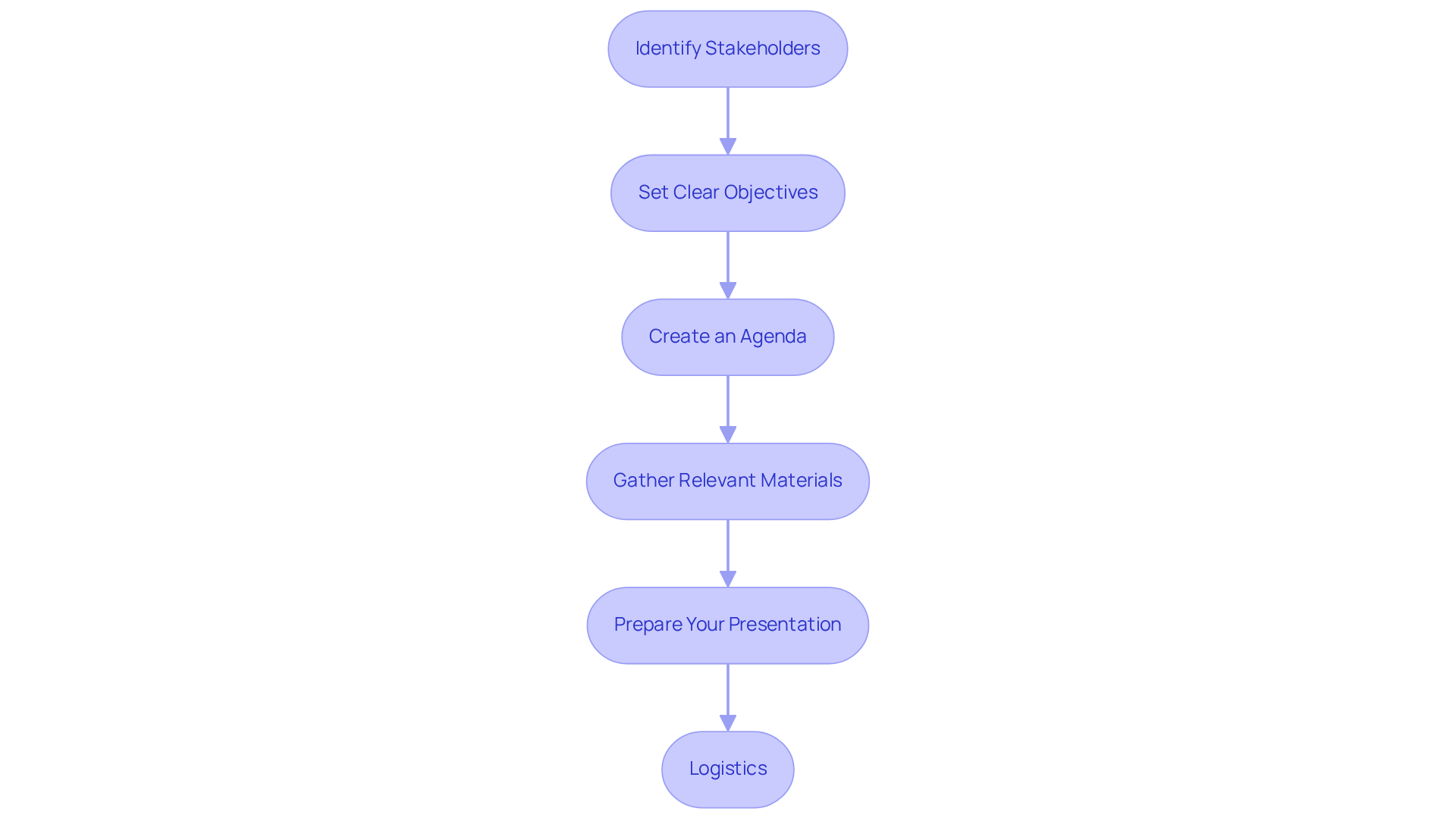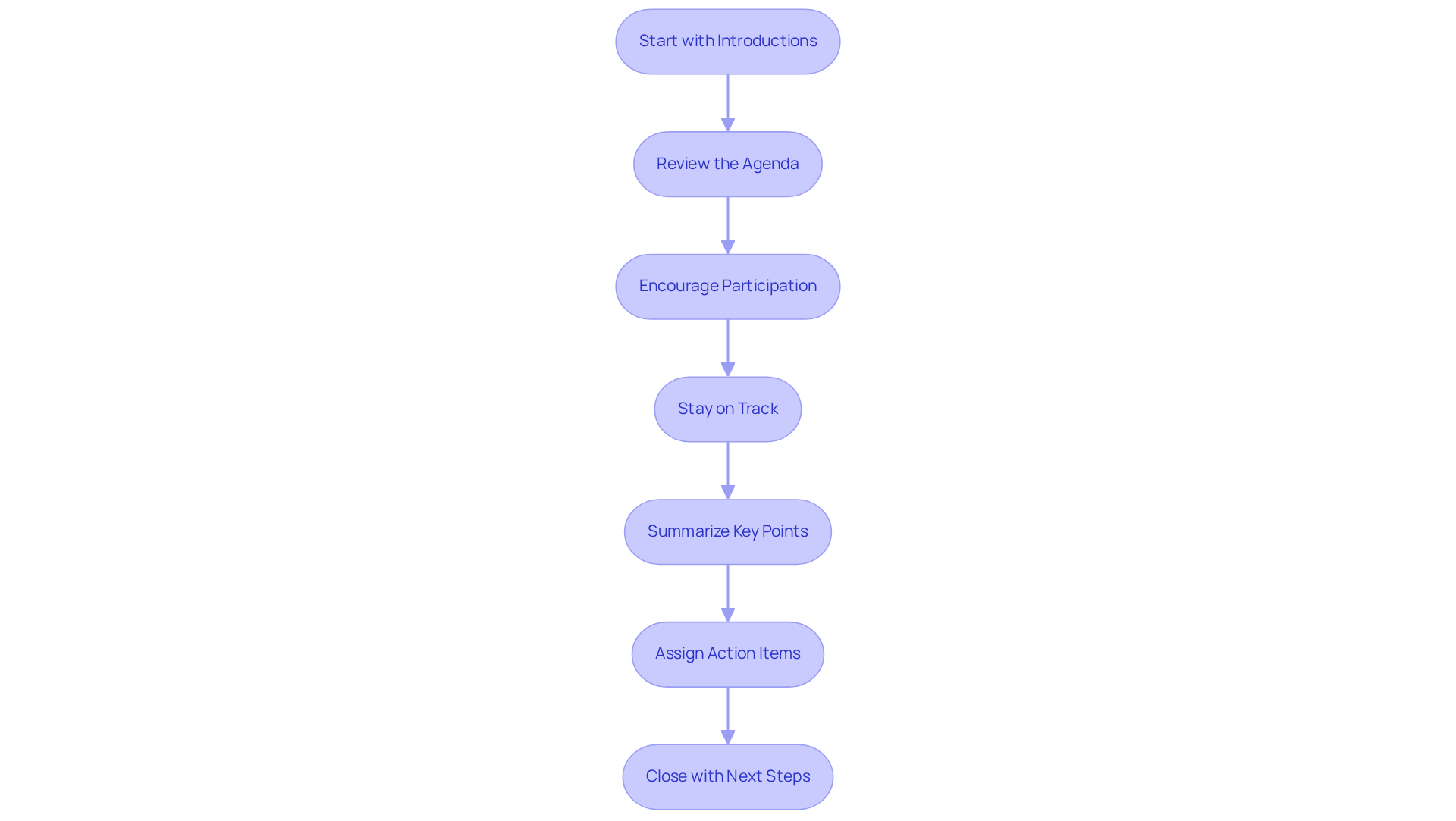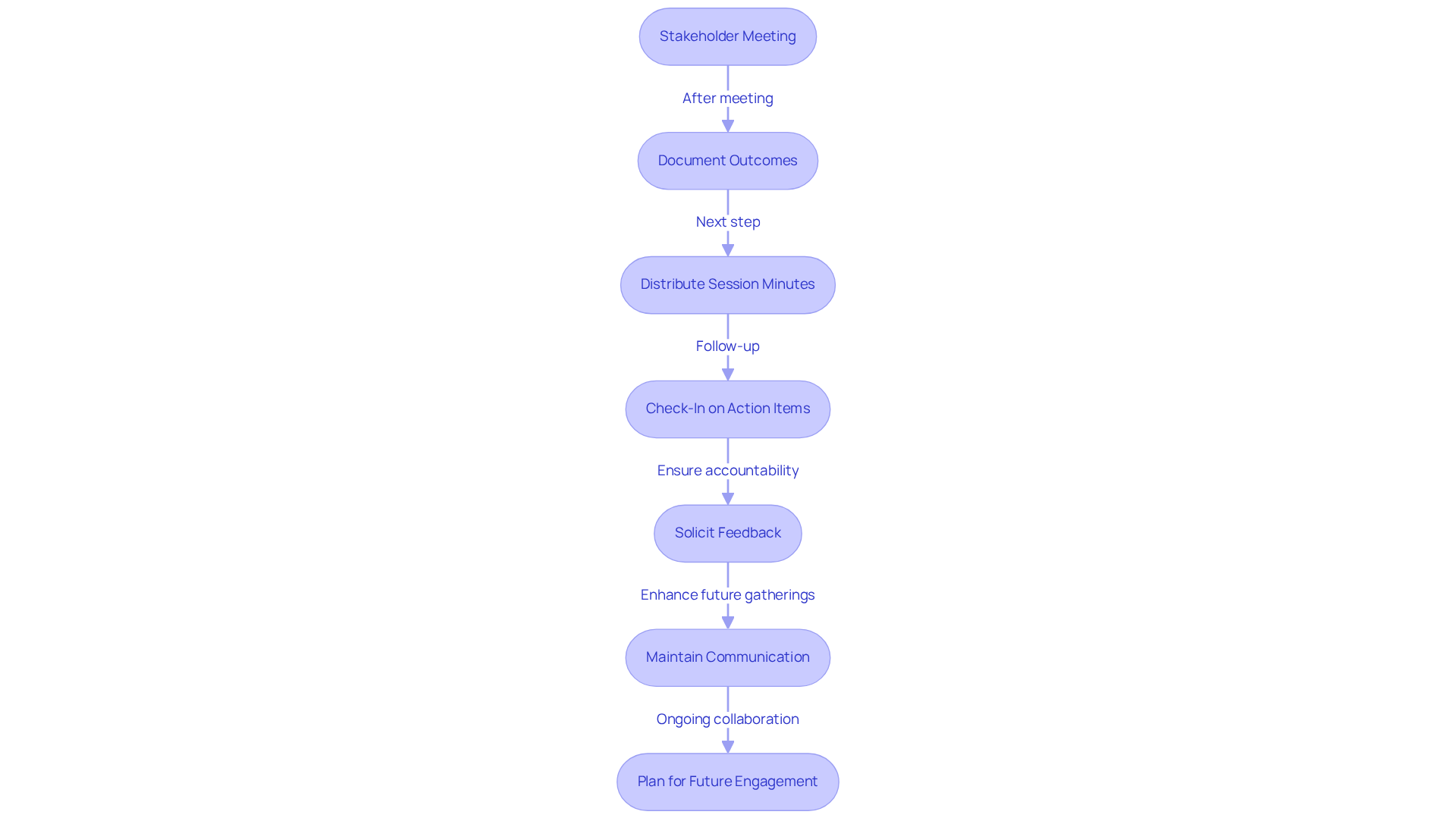Master Stakeholder Meetings: Steps for Effective Engagement

Overview
Stakeholder meetings are essential for overcoming communication inefficiencies that can hinder project success and organizational performance. These meetings foster effective engagement, promote cooperation, gather valuable feedback, and facilitate informed decision-making. By detailing the critical steps for preparing, conducting, and following up on these meetings, the article underscores the necessity of establishing clear objectives and structured agendas. Ongoing communication is vital to ensure accountability and alignment among participants, ultimately enhancing overall project outcomes.
Introduction
Stakeholder meetings are pivotal gatherings that unite individuals and groups with vested interests to collaborate on objectives and make crucial decisions. These meetings enhance cooperation and transparency among teams, significantly improving project outcomes. Organizations that engage stakeholders effectively are more likely to meet their goals on time and within budget. However, despite their importance, many struggle to conduct these meetings productively.
How can organizations ensure that their stakeholder meetings transcend routine gatherings and become powerful catalysts for success?
Define Stakeholder Meetings and Their Importance
A stakeholder meeting represents an organized gathering where individuals or groups with vested interests converge to discuss objectives, share updates, and make pivotal decisions. The significance of these assemblies is underscored by several key benefits:
- Cooperation: These meetings foster cooperation among teams involved in the initiative and interested parties, ensuring alignment on goals and expectations. Organizations that effectively engage stakeholders are 40% more likely to complete tasks on schedule and within budget.
- They provide a vital platform for gathering feedback, which is essential for refining strategies and addressing concerns proactively. Involving stakeholders can lead to a 15% reduction in financial losses in sectors such as banking.
- Decision-Making: Stakeholder meetings serve as essential forums for making critical decisions that influence the project’s trajectory and success. Effective communication of changes is crucial, serving as the lifeblood of successful initiatives. As Jurgen Appelo astutely noted, “The ultimate measure of agility is whether you can keep all your interested parties satisfied.”
- Transparency: Regular interactions foster transparency, building trust and connection among involved parties. High levels of trust within organizations enhance communication and collaboration, resulting in improved performance across all dimensions.
- Risk Management: By discussing potential risks and challenges, participants can collaboratively devise mitigation strategies, bolstering resilience. In the construction sector, effective stakeholder engagement can reduce delivery time by 25%. Moreover, in the service industry, stronger customer relations can elevate satisfaction by up to 30%.
In conclusion, stakeholder meetings are indispensable for effective management and favorable outcomes, establishing them as a priority for any organization striving for operational excellence.

Prepare for the Meeting: Key Steps and Considerations
To prepare effectively for a stakeholder meeting, follow these key steps:
-
Identify Stakeholders: Determine who needs to be present based on their roles and interests in the project. Create a stakeholder map to visualize relationships and influence, ensuring that all relevant parties are included.
-
Set Clear Objectives: Define the purpose of the gathering. What do you hope to achieve? Clear objectives will guide the agenda and discussions at the stakeholder meeting. Notably, 72% of professionals agree that establishing clear goals for gatherings is crucial for success. Furthermore, 61% of C-suite executives link unproductive gatherings to a lack of clear objectives, highlighting the crucial importance of this issue.
-
Create an Agenda: Develop a structured agenda that outlines topics to be discussed, time allocations for each item, and desired outcomes. Distributing this agenda beforehand enables stakeholders to prepare, which is essential since only 37% of workplace gatherings actively utilize agendas, emphasizing the significance of this practice.
-
Gather Relevant Materials: Collect any documents, reports, or data that will be required during the discussion. Ensure that all participants have access to these materials beforehand to facilitate informed discussions.
-
Prepare Your Presentation: If you are leading the discussion, prepare your presentation or talking points. Practicing ensures clarity and confidence, which can significantly enhance engagement.
-
Logistics: Verify the gathering location or virtual platform, ensuring all technical aspects are functioning correctly. Sending reminders to participants as the event date approaches helps maintain attendance and focus.
By following these steps, you can ensure that your stakeholder meeting is productive and focused on achieving its objectives, ultimately enhancing project results and participant satisfaction. As David Smith observes, enhancing organizational culture is crucial for boosting efficiency and minimizing waste, which can lead to substantial savings for organizations—estimated at $37 billion each year in the U.S. because of ineffective gatherings.

Conduct the Meeting: Best Practices for Engagement
To conduct a successful stakeholder meeting, it is crucial to implement best practices that foster collaboration and enhance communication efficiency.
-
Start with Introductions: Initiate the meeting by introducing participants, especially new attendees. This approach fosters rapport and encourages open communication, setting the stage for a productive discussion.
-
Review the Agenda: At the outset, briefly outline the agenda to establish expectations and ensure alignment on discussion topics. This clarity is essential for maintaining focus throughout the meeting.
-
Encourage Participation: Create an inclusive atmosphere by inviting all parties to share their thoughts. Utilize open-ended questions to stimulate discussion; projects with engaged participants succeed 78% of the time compared to 40% with less involvement. Moreover, companies that actively interact with interested parties are 50% more likely to achieve their major objectives, underscoring the importance of involvement.
-
Stay on Track: It is vital to keep the meeting focused on agenda items. If discussions stray, gently redirect them to maintain clarity and purpose, ensuring that the meeting remains productive.
-
Summarize Key Points: Periodically recap discussions to reinforce understanding and ensure alignment among participants. This practice is crucial, as effective involvement of interested parties can lead to a 15% increase in employee retention.
-
Assign Action Items: At the conclusion of each agenda item, assign specific action items to individuals, clarifying responsibilities and deadlines. This enhances accountability, as projects with effective participant plans succeed 83% of the time, highlighting the significance of organized engagement.
-
Close with Next Steps: Conclude the stakeholder meeting by summarizing key decisions and outlining next steps, ensuring all participants understand their roles moving forward.
Implementing these best practices fosters a gathering environment conducive to collaboration and project success, ultimately leading to improved outcomes and reduced risks. As Joshna Dsouza notes, participant satisfaction and feedback are essential for enhancing value within a company.

Follow Up: Document Outcomes and Maintain Engagement
Following a stakeholder meeting, effective follow-up is crucial for ensuring engagement and accountability.
-
Document Outcomes: Create comprehensive notes that detail key discussions, decisions made, and assigned action items. Clarity and precision in documentation are essential, as 63% of participants remember narratives shared during gatherings, while only 5% recall figures. This emphasizes the importance of storytelling in the documentation process.
-
Distribute Session Minutes: Promptly share the session minutes with all participants. This reinforces commitments and keeps everyone informed about what was discussed and agreed upon, ensuring that 80% of sales require five or more follow-ups to convert leads. Linking this to the action items highlights the necessity of persistence in follow-ups.
-
Check-In on Action Items: Regularly follow up on assigned action items to ensure progress. Consistent check-ins can help maintain momentum and accountability, as sales professionals who engage with prospects every 21-30 days experience 47% higher conversion rates. This statistic underscores the importance of regular follow-ups.
-
Solicit feedback during the stakeholder meeting by encouraging stakeholders to provide input on the gathering itself. This not only aids in enhancing future gatherings but also shows that you appreciate their contributions, in accordance with the idea that valuable feedback can transform the world, as mentioned by feedback specialist Helena Bjorkman.
-
Maintain Communication: Keep communication channels open between gatherings. Share updates, pertinent information, and resources that may benefit interested parties. Follow-up emails can significantly boost reply rates, reinforcing the importance of maintaining communication.
-
Plan for Future Engagement: Schedule the next meeting or check-in to ensure ongoing collaboration. This proactive strategy strengthens connections and maintains investors’ involvement in the initiative, as 35-50% of sales go to the vendor that replies first after customer interest.
By implementing these follow-up strategies, you can strengthen stakeholder relationships and ensure that your projects remain aligned with their expectations.

Conclusion
Stakeholder meetings are essential gatherings that unite individuals or groups with shared interests to discuss objectives, share updates, and make critical decisions. Their importance is paramount; effective engagement in these meetings can lead to improved cooperation, transparency, and risk management, ultimately enhancing project outcomes and organizational performance.
Throughout this discussion, several key points underscore the significance of stakeholder meetings. These include:
- The necessity of clear objectives and structured agendas for successful discussions
- Best practices for conducting meetings that foster engagement and collaboration
- The critical follow-up actions that sustain momentum and accountability
By implementing these strategies, organizations can markedly increase their chances of achieving project goals and meeting stakeholder expectations.
Given the insights presented, it is imperative for organizations to prioritize stakeholder meetings as a fundamental aspect of their management processes. Engaging stakeholders effectively not only propels project success but also cultivates enduring relationships that can benefit future initiatives. By committing to best practices in preparation, execution, and follow-up, organizations position themselves to excel in their endeavors, ensuring that all voices are heard and valued in the decision-making process.
Frequently Asked Questions
What is a stakeholder meeting?
A stakeholder meeting is an organized gathering where individuals or groups with vested interests come together to discuss objectives, share updates, and make critical decisions.
Why are stakeholder meetings important?
Stakeholder meetings are important because they foster cooperation among teams, provide a platform for gathering feedback, serve as forums for decision-making, promote transparency, and aid in risk management.
How do stakeholder meetings enhance cooperation?
They enhance cooperation by ensuring alignment on goals and expectations among teams and interested parties, which increases the likelihood of completing tasks on schedule and within budget by 40%.
What role do stakeholder meetings play in decision-making?
They serve as essential forums for making critical decisions that influence the project’s trajectory and success, emphasizing the importance of effective communication of changes.
How do stakeholder meetings contribute to transparency?
Regular interactions during stakeholder meetings foster transparency, building trust and connection among involved parties, which enhances communication and collaboration.
In what ways do stakeholder meetings assist with risk management?
They allow participants to discuss potential risks and challenges, collaboratively devising mitigation strategies that bolster resilience and improve project delivery times.
What are the potential financial benefits of involving stakeholders in meetings?
Involving stakeholders can lead to a 15% reduction in financial losses in sectors like banking and can improve customer satisfaction by up to 30% in the service industry.
